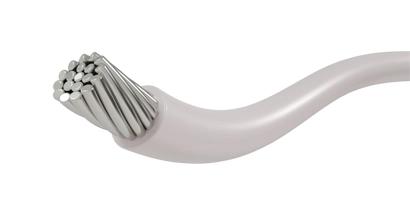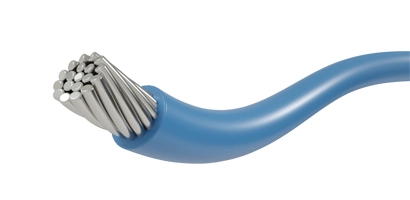Introducing our cutting-edge 150°C & Lower Fluoropolymer-Insulated Wires. Engineered for superior heat resistance and durability, these wires offer reliable performance in demanding environments. Ideal for various industrial applications, ensuring safety and efficiency.

Operating Temperature: -65°C to +150°C
Operating Voltage: 600V
Insulation: PFA
Approval: UL

Operating Temperature: -65°C to +150°C
Operating Voltage: 300V
Insulation: PTFE
Approval: UL

Operating Temperature: -65°C to +150°C
Operating Voltage: 600V
Insulation: PTFE
Approval: UL/cUL

Operating Temperature: -65°C to +80°C
Operating Voltage: no requirements
Insulation: PTFE
Approval: UL

Operating Temperature: -65°C to + 150°C
Operating Voltage: 600V
Insulation: FEP
Approval: UL

Operating Temperature: -65°C to + 150°C
Operating Voltage: 300V
Insulation: FEP
Approval: UL

Operating Temperature: -65°C to +150°C
Operating Voltage: 300V
Insulation: FEP
Approval: UL

Operating Temperature: -65°C to +150°C
Operating Voltage: 150V
Insulation: PFA
Approval: UL

Operating Temperature: -65°C to +150°C
Operating Voltage: 300V
Insulation: PFA
Approval: UL

Operating Temperature: -65°C to +150°C
Operating Voltage: 600V
Insulation: PFA
Approval: UL

Operating Temperature: -65°C to +105°C / 150°C / 200°C
Operating Voltage: 300V
Insulation: PTFE
Approval: UL

Operating Temperature: -65°C to +150°C/200°C
Operating Voltage: 600V
Insulation: extruded FEP
Approval: NEMA HP4 Type K ex. MIL-W-16878/ 11

Operating Temperature: -65°C to + 150°C/200°C
Operating Voltage: 1000V
Insulation: FEP
Approval: NEMA HP4 Type KK ex. MIL-W-16878/12

Operating Temperature: -55°C to +150°C/200°C
Operating Voltage: 250V
Insulation: extruded FEP
Approval: NEMA HP4 Type KT ex. MIL-W-16878/13

Operating Temperature: 150°C
Operating Voltage: 600V
Insulation: extruded ETFE
Approval: MIL-W-22759 / 16 / 17 / 18 / 19

Operating Temperature: 150°C
Operating Voltage: 600V
Insulation: extruded ETFE
Approval: MIL-W-22759 / 16 / 17 / 18 / 19
150°C and lower fluoropolymer-insulated wires are a type of electrical wire where the conductors are coated or insulated with fluoropolymer materials capable of withstanding temperatures up to 150°C or lower. These wires are specifically designed for applications that require high-temperature resistance, exceptional chemical resistance, and reliable electrical performance in challenging environments.
Insulation Material: Fluoropolymer-insulated wires use specialized fluoropolymer materials such as FEP (fluorinated ethylene propylene), PFA (perfluoroalkoxy), ETFE (ethylene tetrafluoroethylene), or PVDF (polyvinylidene fluoride) to coat or insulate the electrical conductors.
Temperature Rating: These wires are engineered to operate continuously at temperatures up to 150°C or lower without compromising the insulation integrity or electrical properties. Some fluoropolymer formulations may have higher temperature ratings for intermittent or short-duration use.
1. Automotive Industry:
Engine Compartment Wiring: Used for wiring harnesses, sensors, and components in automotive engine compartments where exposure to high temperatures is frequent.
Underhood Applications: Employed in vehicles for wiring systems that require thermal stability and resistance to automotive fluids and oils.
2. Aerospace and Aviation:
Aircraft Wiring: Used in aircraft electrical systems, avionics, and instrumentation where lightweight, high-temperature-resistant cables are essential for safety and performance.
Spacecraft and Satellites: Utilized in aerospace applications for wiring and interconnections that can withstand extreme temperature variations and space environments.
3. Industrial Heating and Processing:
Industrial Ovens and Furnaces: Used in heating elements, sensors, and control systems for industrial heating equipment operating at high temperatures.
Chemical Processing Plants: Employed in instrumentation and control wiring in chemical plants and refineries where resistance to corrosive chemicals and elevated temperatures is crucial.
4. Electronics and Electrical Equipment:
High-Temperature Electronics: Used in electronic devices, circuit boards, and sensors that require reliable electrical insulation at elevated temperatures.
Power Electronics: Employed in power supply units, inverters, and converters where high-temperature performance is necessary.
5. Renewable Energy Systems:
Solar Energy: Used in solar panel installations and solar farms for wiring that can withstand outdoor exposure and high temperatures.
Wind Turbines: Employed in wind turbine systems for electrical connections and controls exposed to environmental elements and temperature fluctuations.
6. Chemical and Petrochemical Industries:
Chemical Processing Equipment: Utilized in instrumentation and wiring for chemical reactors, pumps, and valves in chemical processing plants and petrochemical facilities.
Oil and Gas Industry: Used in equipment and instrumentation for oil drilling, refining, and exploration applications.
7. Laboratory and Research Equipment:
Scientific Instruments: Employed in laboratory equipment, analytical instruments, and research devices requiring high-temperature-resistant wiring.
8. Medical Devices and Healthcare:
Medical Equipment: Used in medical devices, diagnostic equipment, and surgical instruments requiring biocompatibility, sterilization resistance, and thermal stability.
9. Telecommunications and Data Centers:
Telecommunications Infrastructure: Utilized in telecommunications networks, data centers, and networking equipment for reliable signal transmission and performance.
10. Consumer Electronics:
Consumer Appliances: Employed in household appliances, such as ovens, stoves, and heating equipment, requiring heat-resistant wiring.